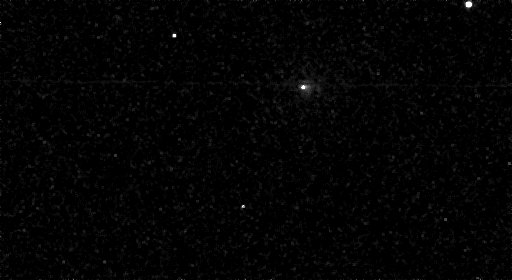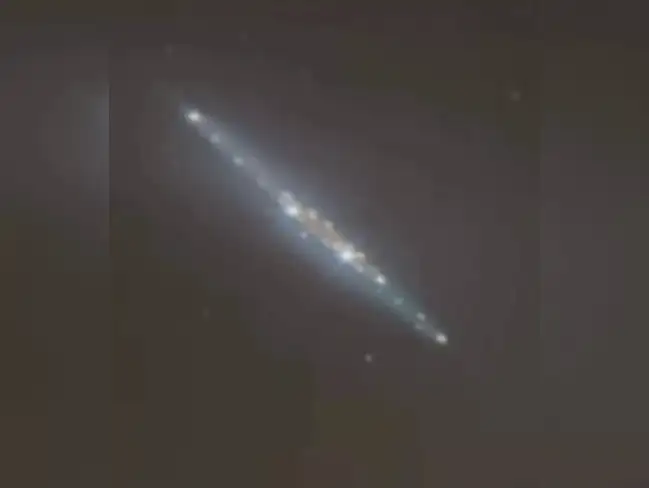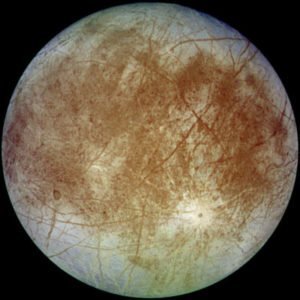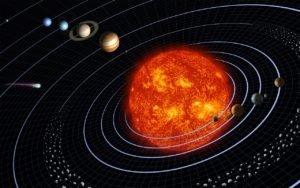ESA’s ExoMars Trace Gas Orbiter and Mars Express spacecraft recently observed the interstellar comet 3I/ATLAS as it sailed past Mars. This close encounter offers a unique opportunity to study a rare visitor from beyond our Solar System, revealing potential insights into the genesis of worlds far from our own.
Observation from Mars
The European Space Agency (ESA)’s ExoMars Trace Gas Orbiter and Mars Express spacecraft had an exceptional task: capturing images of the interstellar comet 3I/ATLAS as it made its closest approach to Mars on October 3. Observing an interstellar comet from Mars involved several challenges, but it presented a rare opportunity to learn more about the mysterious regions beyond our solar system.

Image description: ExoMars TGO images comet 3I/ATLAS
A black space background dotted with small white stars. Near the centre, a slightly fuzzy, bright white dot moves downward through a set of frames – this is comet 3I/ATLAS.CREDIT: ESA/TGO/CaSSIS
LICENCE: CC BY-SA 3.0 IGO or ESA Standard Licence
These interstellar visitors differ from the usual comets and asteroids within our solar system. They move at high velocities, originating from distant star systems. Capturing clear images of such high-speed travelers is technically demanding. The dimness of 3I/ATLAS, resulting from its ancient and distant origin, made it even more challenging. The paucity of light reflecting off its surface posed a significant obstacle in acquiring detailed images.
The ExoMars Trace Gas Orbiter and Mars Express are equipped with sophisticated imaging systems. The ExoMars Orbiter boasts a high-resolution camera designed for atmospheric monitoring, while Mars Express is equipped with a stereo camera for capturing detailed surface and celestial images. Although these systems have provided us with invaluable data about Mars’ surface and atmosphere, capturing an interstellar comet is a different venture. The faintness of 3I/ATLAS scattered across the sky required careful calibration and technical finesse. Pointing these cameras accurately while accounting for the comet’s high velocity was a complex task. The scientific teams had to optimize exposure times to enhance the quality of the images without overexposing the spacecraft’s sensors to Martian sunlight.
Despite these challenges, the mission successfully captured a series of images revealing unique features. The images displayed a diffuse coma surrounding the comet’s core, hinting at material shedding from its icy surface as it neared the Sun. Interestingly, the data implied unusual spectral signatures, unlike any observed from solar system comets. These findings intrigued scientists, offering evidence that 3I/ATLAS contained materials formed in radically different environments than those we understand. This discovery bolstered the hypothesis that interstellar comets like 3I/ATLAS carry unique chemical signatures.
By studying these signs, scientists hoped to glean information about the early conditions of the comet’s origin regions. These observations could illuminate the processes of star formation and the materials present in different parts of the galaxy. Each interstellar comet is like a time capsule, offering glimpses of the galaxy’s distant past.
Collectively, the data captured that day provided a rare glimpse into the diverse nature of the building blocks of planet formation scattered across the universe. Scientists anticipate uncovering a wealth of information about the materials that constitute distant star systems. Insights from this mission could refine our understanding of solar system formation and provide a broader perspective on potential chemical combinations in the galaxy.
ESA anticipates further collaboration between in-orbit observatories, telescopes on Earth, and space-based projects, enhancing our methods of detecting future interstellar objects. Moreover, the potential for these rare objects to be sampled by future robotic missions adds an exciting dimension to ongoing and upcoming research initiatives.
In navigating these challenges and capturing meaningful data, ExoMars and Mars Express have contributed significantly to a growing body of knowledge about interstellar objects. As scientists delve deeper into data analysis, the scientific community remains optimistic about what comet 3I/ATLAS’s material composition and path might reveal about the universe beyond our solar system.

Avi Loeb said that 3I/ATLAS displayed the first evidence of a non-gravitational acceleration by the date of its perihelion. (Photo: X/@RealTruthDoctor)
The opportunity to learn from such rare events underscores the importance of global collaborations in space exploration. As technologies improve and more interstellar visitors pass through, our ability to gather data improves. The observations from Mars, while challenging, are a testament to technological innovations and the human quest for understanding celestial phenomena. This endeavor demonstrates the value of celestial observations in answering questions about the universe’s origins, particularly those unveiled by rare interstellar travelers.
For readers interested in astronomy and interstellar phenomena, exploring similar topics can enrich understanding. The Scienceteen blog provides various resources on astronomy, such as their collection of astronomy software programs and online telescope tools, which can offer further insights into observing celestial events.
The Significance of Interstellar Comets
Interstellar comets, such as 3I/ATLAS, hold a special place in our exploration of the cosmos. These celestial wanderers are cosmic messengers, bearing the stories of distant stars and the vast expanse of the universe. They offer a unique glimpse into the formation processes that occur outside our solar system. To uncover their significance, one must delve into their unique characteristics and insights into the galaxy’s history.
Interstellar comets differ fundamentally from their solar system counterparts. While comets within our solar realm originated from either the Kuiper Belt or Oort Cloud, interstellar comets like 3I/ATLAS emerge from regions far beyond. Their journeys might span hundreds of thousands of years, traversing the vast emptiness between stars. This travel carries them across varied interstellar environments, subjecting them to conditions that differ greatly from those experienced within our solar system. The opportunity to study these objects is exceedingly rare, making each encounter incredibly valuable.
Their origins provide significant clues about the environments in which they formed. Chemical analyses of 1I/ʻOumuamua, 2I/Borisov, and now 3I/ATLAS offer insights into the molecular clouds and nascent solar systems elsewhere in the galaxy. Unlike solar system comets, which share a similar material inventory, interstellar comets showcase different elemental and molecular compositions. This diversity illustrates the range of conditions in the universe and supports the idea that planetary systems can form under various scenarios.
By analyzing these differences, scientists can extrapolate the temperature, density, and chemical environment of their birthplaces. For example, the unexpected presence of nitrogen contained in 2I/Borisov indicated its origins in a colder region than typically found around young stars. Such clues help refine models of planetary system formation and evolution by expanding our understanding beyond the constraints of our solar neighborhood.
Another reason these comets are unique is their resilience. The prolonged journey through interstellar space likely alters their physical and chemical make-up, with some components decomposing or interacting with cosmic radiation. This transformation provides scientists with a natural laboratory to understand the potential outcomes of interstellar materials interacting with space environments.
Moreover, interstellar comets offer insights into the dynamism of star systems. Their ejection into interstellar space points to dynamic processes, such as gravitational interactions with giant planets during the early stages of system evolution. These interactions might be more violent or frequent than we can currently reconstruct from our solar system’s relatively stable state. Understanding the mechanics of these ejections could illuminate the ways systems eject or capture comets, adding a layer to the narrative of planetary system development.
3I/ATLAS brings with it a continuation of human curiosity about the cosmos, after the landmark observations of 1I/ʻOumuamua and 2I/Borisov. The former, with its unusual elongated shape and lack of typical cometary behavior, provoked questions about the nature of interstellar objects. On the other hand, 2I/Borisov, displaying more familiar characteristics with a coma and tail, confirmed that some interstellar comets mirror solar system ones.
Scientific endeavors like the ESA ExoMars and Mars Express missions, which capture detailed images and spectra of such objects, help construct an archive of interstellar travelers. Each observation adds layers of information, paving the way for constructing a comprehensive picture of our own solar system’s place in the galaxy. These missions benefit from technological advancements, allowing for more precise and extensive data gathering than ever before.
Interstellar comets challenge existing cosmological theories and prompt new scientific inquiries. For instance, if analyzed thoroughly, they could help pinpoint isotopic anomalies or unknown elements, contributing to our understanding of galactic chemical evolution. Their untouched substance comes directly from the molecular clouds where stars and planetary systems begin, offering a slice of pristine cosmic history otherwise obscurred.
Furthermore, these comets encourage pondering broader cosmological questions. What percentage of star systems eject such objects, and how common are they in the galaxy? These queries lead to investigations into stellar population dynamics, informing models of galactic evolution. Understanding the frequency and origin of such objects enlightens the narrative of the Milky Way itself.
Studying interstellar visitors could also hone our skills in planetary defense. Should an interstellar object pose a collision threat, the knowledge gained from benign scientific study would be invaluable in crafting mitigation strategies. Each comet represents an opportunity to test existing theories under new conditions, allowing adaptation to scenarios that may surface.
Lastly, these exceptional entities fuel public interest in space exploration. Their journeys, spanning light-years, encapsulate the human spirit of discovery, compelling engagement and support for scientific missions. Interstellar comets like 3I/ATLAS not only enrich our scientific understanding but also inspire future generations to look beyond our earthly confines in pursuit of knowledge.
The significance of interstellar comets is multi-layered, from the scientific to the philosophical. As emissaries from far-flung regions, they remind us of the universe’s grand tapestry, woven from myriad stars and worlds. With the advent of missions like the ESA’s ExoMars and the upcoming Comet Interceptor, our exploration and understanding continue to deepen, ensuring that these cosmic wanderers play a crucial role in unraveling the mysteries of the universe in which we find ourselves.
Explore other mysteries of our solar system and compare them to the insights offered by these interstellar guests. As we stand on the brink of new discoveries, remember that each interstellar comet offers another piece in the puzzle of our cosmic surroundings, connecting us to distant stars and the vast stretches between them.
Future Missions and Continuing Discoveries
As we continue to explore the universe, humanity’s fascination with celestial phenomena grows ever more profound. In this context, the pursuit of interstellar comets holds enormous potential for uncovering new secrets about our cosmos. Interstellar comets, like the notable 3I/ATLAS, offer a window into distant corners of the galaxy, effectively acting like time capsules from other star systems. To unlock these secrets, future space missions are being meticulously planned, focusing on these enigmatic visitors and other celestial phenomena.
Among the most promising upcoming missions is the European Space Agency (ESA) Comet Interceptor. This ambitious endeavor seeks to launch a spacecraft capable of intercepting a long-period comet or an interstellar object like 3I/ATLAS. Unlike traditional comet missions, which often take years of travel, the Comet Interceptor will lie in wait at the Lagrange Point 2, poised to spring into action as soon as a suitable target is identified. This strategic positioning ensures a timely and efficient deployment, maximizing scientific returns.
The primary goal of the Comet Interceptor mission is to capture high-resolution data from comets that have never approached the Sun. These comets remain unchanged since their formation, representing pristine samples of the early solar system. An interstellar target, on the other hand, would provide insights into processes occurring beyond our solar exterior, offering clues about the building blocks of other planetary systems.
Scientific objectives for the Comet Interceptor are manifold. They include analyzing the physical and chemical properties of the comet’s nucleus, examining its dust environment, and studying its interaction with solar wind. The data collected could reveal the composition of ancient material that predates our solar system, providing a glimpse into the chemical conditions from which our own planet evolved. This information is fundamental for understanding organic matter distribution throughout the universe and, consequently, the potential origins of life.
In addition to the Comet Interceptor, ESA is also preparing other instruments that promise exciting discoveries. The Jupiter Icy Moons Explorer (JUICE) is set to explore Jupiter’s ocean-bearing moons, but its observations are not limited only to these Jovian satellites. While primarily focused on moons like Ganymede, Callisto, and Europa, JUICE’s sophisticated instruments could also capture distant observations of passing interstellar objects. These incidental observations could shed light on cometary activity from afar, complementing our understanding gained through direct exploration.
Moreover, synergistic contributions from other missions like NASA’s James Webb Space Telescope and various ground-based observatories will vastly enhance our understanding of interstellar comets. Observatories are becoming increasingly adept at spotting incoming interstellar targets early, potentially allowing more fine-tuned and comprehensive mission plans. This collaborative approach underscores the importance of international cooperation in addressing the vast and complex questions these cosmic travelers pose.
As our ability to observe the cosmos advances, so too does our potential for groundbreaking discoveries. The exploration of interstellar comets, facilitated by missions like Comet Interceptor, promises to redefine our understanding of the universe’s formation and evolution. By analyzing these ancient and untouched relics, we hope to fill gaps in our knowledge about the diversity and commonality among planetary systems.
Interstellar comets challenge existing models of planetary formation and composition. Their study may reveal unexpected types of chemistry and physical processes, prompting a reevaluation of the theories on planetary systems’ birth. Similarly, the data acquired may illuminate poorly understood mechanisms of comet dynamics and structure, crucial for piecing together the broader cosmic puzzle.
The pursuit of these enigmatic objects extends beyond scientific curiosity; it is a quest deeply rooted in humanity’s innate desire to understand its place in the universe. Each successful mission not only enriches our scientific repository but also inspires future generations of scientists, astronomers, and dreamers.
The continuous advancements in technology, the innovative nature of missions like Comet Interceptor, and the dedication of the global scientific community all converge towards a common goal: to explore and understand the cosmos in all its complexity. In doing so, we continually push the boundaries of knowledge, inching ever closer to answering profound questions about the origin and nature of our universe. For those captivated by the stars, the future holds infinite possibilities, drawing us ever forward into the cosmic unknown.
As we look to the skies with an ever-inquisitive spirit, the expected observations from these missions may yield revolutionary breakthroughs. Perhaps these insights will change our understanding of planetary genesis, cosmic chemistry, and even extraterrestrial life potential. Each discovery propels us one step closer to unveiling the marvels of the universe, strengthening our bond with the celestial bodies that have enchanted humanity for millennia.
For a broader understanding of this venture, a glimpse into how breakthroughs in technology complement cosmic explorations might be of interest. Such advancements often serve as the backbone for ambitious missions like these. One can explore more on the topic through how technological innovations support space exploration.
The culmination of scientific efforts, like those driving ESA’s missions, rests upon the foundations laid by countless earlier endeavors. As more missions unfold and telescopes capture ever-distant objects, each bit of new data keeps the spirit of discovery alive, uncovering truths that continue to astound and inspire the curious mind.
Final words
The observations of comet 3I/ATLAS by ESA’s Mars orbiters barely scratch the surface of what these interstellar visitors can teach us about our universe. As ESA prepares future missions to intercept these objects, our understanding of cosmic origins may vastly expand, offering new insights into the mysteries beyond. Stay updated with ESA’s endeavors for more cosmic discoveries.



